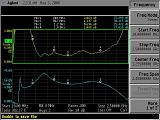I have a Wilson Yagi Antenna for 700/850MHz, specialized high-gain - 301111 and would like to know what would be the best low noise preamp to help improve reception? I have a Homepatrol unit.
Thank You
Tom
Thank You
Tom
I wouldn't use a tv preamp if I were you. They are generally poor quality and more likely to induce intermod than a higher quality preamp. Just getting "more bars" is not the goal of a preamp.
The first thing you need to do is decide if you actually need one. What's happening that makes you think so?
It's quite possible that a preamp won't help that. The best you can hope for is to make marginal reception not marginal. If there's no signal at all, a preamp won't fix it. How far away are the stations you want to hear, but can't?I have a few locations that I want to receive that are coming in only when the conditions are right.
That's not surprising. Scanners are already pretty sensitive. Adding gain frequently will overdrive the scanner with noise, and cause intermod. What type of preamp did you use? Most preamps have way too much gain, so need some attenuation between the preamp and the receiver.I added a amp but it did not help and only increased the noise level not the signal.
A preamp should be one of the last things you do to "fix" your antenna system.
Start with the coax, especially at the higher frequencies like 800 MHz. A good low-loss coax is a must unless you have nothing but strong signals (and if so, why would you want a pre-amp). For short runs (up to 50' or so), RG-6 should be the minimum you should use. LMR-400 is a must for longer runs (say 50' - 150'). LDF4-50A should be used for anything much over 100' or so. Keep in mind that these are the minimum grade of coax you should use!
Next start with a good antenna that's designed for the frequency range(s) you're listening to (note the "listening to" part of that, I'm saying not to match your antenna's range to your scanner's range or you'll end up with a wide-bandwidth but minimal signal strength antenna). A good antenna designed specifically for 800 MHz and has good gain numbers on that band will give you much more signal for the same cost as a general coverage antenna.
If you have some special needs (simulcast issues, distant systems you want to cover, etc.) you may need a more specialized antenna. A directional yagi will give you much higher gain numbers and allow you to focus the energy from a single tower to help fix either of those issues.
Height is often your friend with scanning. Having your antenna up as high as you can will often provide you the best signal strength. The down side is your coax run will need to be longer (perhaps much longer) so you'll need to use a better grade coax.
If you have a great antenna, designed for the band you're listening to, feed with a high quality low-loss coax, on a tall tower and still need help pulling in that signal you may simply not be in an area where you can get a good signal on it. It may be worth trying a good preamp (located by the antenna) to see if it helps or hurts your reception.
You'll probably also need to add some filters to prevent nearby strong signals from overloading the preamp and/or receiver. What filter can't be guessed at from afar, but must be searched out at the location in question. It's very hard to guess what signals may be strong enough without actually looking around and doing some scanning for strong signals. The places to start looking are cell towers nearby (up to a couple of miles), FM or TV broadcast towers nearby (could be up to 10+ miles away), NOAA Weather Radio stations, paging stations, or even standard two way radio towers ("nearby" is very relative here based on their transmitter power levels).


I tried my model 9263 amp did nothing to improve and made it worse...........
Pricing and puchasing inforation for low noise 0.4 dB NF HDTV preamplifiers
Works great for my tv antenna
What frequencies are you interested in receiving?
The 9263 amp is for VHF (175 MHz - 700 MHz)
Without testing it above 700 MHz, it's unknown if it's useful above that range.
It may have some filtering that attenuates everything above 700 MHz or so.
Or, you could have strong signals nearby that desensitize your scanner when you add a preamp.
Rich
I should have mentioned the amplifier I like to use in the 800-900 MHz range.
I use several Mini-Circuits ZQL-1900MLN amplifiers.
The specifications are higher than the 800-900 MHz range but if you look at the first image below, you'll see that they have good gain and low noise figure well below their specified range.
They're around $265 brand new, but ........................
you can find them on ebay for around $40-$50 or so.
The specifications for the ZQL-1900MLN:
1.5 dB noise figure
25 dB gain
IP3 around 41 dBm
I mount them in a weather resistant enclosure like I show in this post:
http://forums.radioreference.com/sc...wering-versus-remote-powering.html#post860180
Rich
Mini Circuits ZQL-1900MLN

found one on ebay for $39.00 plus small fee shipping...........
found one on ebay for $39.00 plus small fee shipping...........
found one on ebay for $39.00 plus small fee shipping...........




